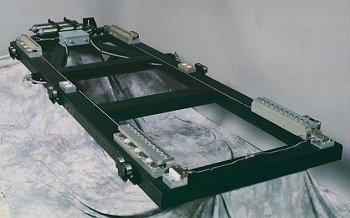The Carriage or “sled” is approximately 4 feet wide by 12 feet long, and weighs approximately 1800 pounds (820kg). It has a maximum payload capacity of 5,000 pounds (2,270 kg).
 The top of the carriage is flat, and the sides are unobstructed at least 2 inches below the top-mounting plane.
The top of the carriage is flat, and the sides are unobstructed at least 2 inches below the top-mounting plane.
The top plate has a pattern of tapped ½-inch mounting holes located on 3-inch centers. A carriage top plate with metric hole sizing and spacing may be selected, if desired. Additional mounting holes are placed on the sides and rear of the frame.
Two brake systems are included in the standard HYGETM. The first system (Primary) is a brake that is energized prior to firing and remains on during the firing. The second standard system is an emergency brake system mounted on the carriage that is actuated by a cam switch farther down the track. If the first system fails or has not been energized, the second system will trip and stop the sled before the end of the rail system.
All brake zones are provided with ports for mounting pressure transducers and isolation valves between Zones
The carriage pneumatic brakes operate on the rails through brake shoes. The maximum drag force from the carriage is at least 12,000 pounds (5,450 kg).
Options
- Roller assembly to raise the sled off the slider pads to allow easier return of the sled to its firing position.
- A third braking system ( second Tank) for use as delay braking. This allows sled to be fired with out Primary brake being applied, for pulses requiring for faster rise time of pulse leading edge. Like the emergency brake system it is actuated by a separate cam switch down the track before the emergency ramp and operated at lower pressure for a more gradual stopping of sled
- Mount pressure transducers on Brake Zones


